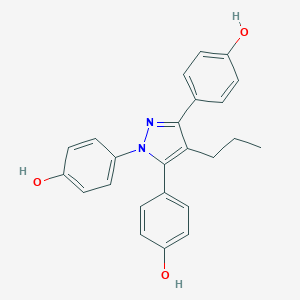| 1 |
URL: http://www.guidetopharmacology.org Nucleic Acids Res. 2015 Oct 12. pii: gkv1037. The IUPHAR/BPS Guide to PHARMACOLOGY in 2016: towards curated quantitative interactions between 1300 protein targets and 6000 ligands. (Ligand id: 2819).
|
| 2 |
Conformational changes and coactivator recruitment by novel ligands for estrogen receptor-alpha and estrogen receptor-beta: correlations with biological character and distinct differences among SRC coactivator family members. Endocrinology. 2000 Oct;141(10):3534-45.
|
| 3 |
Morphologic effects of estrogen stimulation on 3D MCF-7 microtissues. Toxicol Lett. 2016 Apr 25;248:1-8.
|
| 4 |
Estradiol downregulates miR-21 expression and increases miR-21 target gene expression in MCF-7 breast cancer cells. Nucleic Acids Res. 2009 May;37(8):2584-95. doi: 10.1093/nar/gkp117. Epub 2009 Mar 5.
|
| 5 |
Estrogen and selective estrogen receptor modulators exert neuroprotective effects and stimulate the expression of selective Alzheimer's disease indicator-1, a recently discovered antiapoptotic gene, in human neuroblast long-term cell cultures. J Clin Endocrinol Metab. 2005 Mar;90(3):1775-82.
|
| 6 |
The Ah receptor inhibits estrogen-induced estrogen receptor beta in breast cancer cells. Biochem Biophys Res Commun. 2004 Jul 16;320(1):76-82. doi: 10.1016/j.bbrc.2004.05.132.
|
| 7 |
Cadmium promotes breast cancer cell proliferation by potentiating the interaction between ERalpha and c-Jun. Mol Endocrinol. 2010 May;24(5):981-92. doi: 10.1210/me.2009-0410. Epub 2010 Mar 10.
|
| 8 |
17-Estradiol Activates HSF1 via MAPK Signaling in ER-Positive Breast Cancer Cells. Cancers (Basel). 2019 Oct 11;11(10):1533. doi: 10.3390/cancers11101533.
|
| 9 |
The effect of estrogen compounds on human embryoid bodies. Reprod Sci. 2013 Jun;20(6):661-9. doi: 10.1177/1933719112462630. Epub 2012 Nov 26.
|
| 10 |
Epigenetic influences of low-dose bisphenol A in primary human breast epithelial cells. Toxicol Appl Pharmacol. 2010 Oct 15;248(2):111-21.
|
|
|
|
|
|
|



